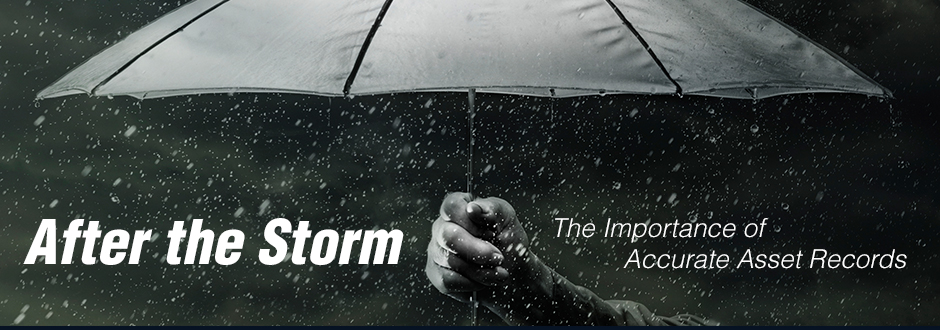Wasp Barcode Technologies: The Barcode Solution People
After the Storm: The Importance of Accurate Asset Records

Superstorm Sandy, hurricanes Katrina and Rita, and the 2013 OK tornados were all shocking, unfortunate reminders of Mother Nature’s power. While some businesses, homes, and schools escaped relatively unscathed, others suffered catastrophic losses. Unforeseen disasters, natural or otherwise, can cause a business to be turned upside down—18,700 Louisiana businesses were impacted by hurricanes Katrina and Rita,
265,300 New York businesses were affected by Superstorm Sandy and
6,133 businesses in Moore, OK were damaged by one tornado, 75% of those were considered small businesses.
For each area devastated by the above disasters, recovery has been long and arduous; however, organizations with disaster recovery plans have had a significant head start. Advance preparation has allowed those businesses to get back on their feet quickly—filing insurance claims and beginning the replacement of lost assets.
Are You Covered?
After a natural disaster, there’s a widespread presumption insurance covers all losses. Unfortunately, that’s not usually the case. First, not every type of disaster is covered. Flooding is perhaps the best known exclusion. If rain leaks through a hole in your roof and destroys a computer, your insurance will probably cover the replacement. In contrast, if flood water rises, enters through a doorway, and soaks your laptop, chances are that damage wouldn’t be covered – unless you’ve been paying for additional flood insurance.
One additional insurance option for businesses is called Business Interruption. This coverage provides income while you rebuild or replace lost assets. Whether you have the most basic coverage or you’ve added extra provisions to your policy, it will take time to receive a payout, and the amount might be less than you expected. Many states limit how long an insurance company can delay before settling a claim (see the
National Association of Insurance Commissioners website for state-by-state details), but it could be two months or more before you see any money; that’s a long time to be without vital equipment.
Where are Your Records?

Having documentation to prove your losses is an essential requirement of the claims process. Implementing an
asset management system guarantees you have accurate, detailed, and current information to provide when filing a claim. An asset solution tracks all of the equipment owned by your organization using a method that allows for easy data recovery. In contrast, a pen and paper tracking method not only increases the potential for human error, it also creates a record that can be just as easily lost as physical assets.
An easily accessible and recoverable asset list is imperative, but the list’s value depends on the quality of information it holds. As an effective tool for managing asset information, when items are purchased, moved, or retired, that detail must be recorded in the software. It is especially important to document
money spent on maintenance, repairs and improvements, as well as the initial cost and date of purchase because those details will affect each item’s replacement value.
How Vulnerable is Your Organization?
You business’s vulnerability to natural disaster really depends on geography. You may reside in a location with very low risk of tornado, hurricane, earthquake or flood. However, just because those risks are low doesn’t mean your assets aren’t susceptible to other forms of loss – fire, theft or vandalism. Keeping accurate records within an automated asset management system not only makes your day-to-day asset tracking easier, it is a vital part of every disaster recovery plan.
Has proper asset management helped your business recover from the effects of a disaster? Leave a comment to tell Wasp Barcode your story.
 Superstorm Sandy, hurricanes Katrina and Rita, and the 2013 OK tornados were all shocking, unfortunate reminders of Mother Nature’s power. While some businesses, homes, and schools escaped relatively unscathed, others suffered catastrophic losses. Unforeseen disasters, natural or otherwise, can cause a business to be turned upside down—18,700 Louisiana businesses were impacted by hurricanes Katrina and Rita,
Superstorm Sandy, hurricanes Katrina and Rita, and the 2013 OK tornados were all shocking, unfortunate reminders of Mother Nature’s power. While some businesses, homes, and schools escaped relatively unscathed, others suffered catastrophic losses. Unforeseen disasters, natural or otherwise, can cause a business to be turned upside down—18,700 Louisiana businesses were impacted by hurricanes Katrina and Rita,  Having documentation to prove your losses is an essential requirement of the claims process. Implementing an
Having documentation to prove your losses is an essential requirement of the claims process. Implementing an 

